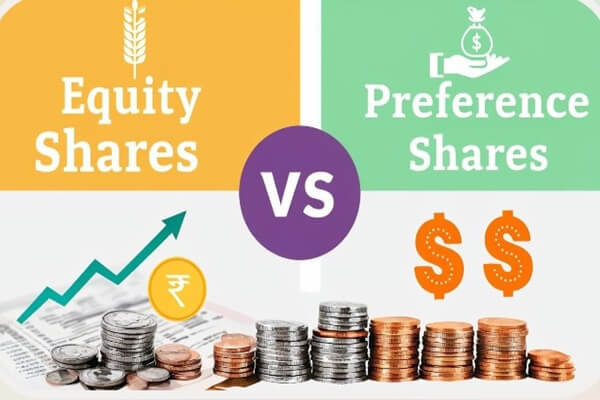Thinking about investing in shares but unsure whether to go for equity or preference shares? You’re not alone! Many investors struggle to understand the key differences between these two types of shares and how they impact returns, risk, and overall investment strategy.
In this guide, we’ll break it all down in simple terms, so you can confidently choose the best option for your financial goals. Let’s dive in!
What Are Equity Shares?
Equity shares—also called common or ordinary shares—represent ownership in a company. When you own equity shares, you essentially become a part-owner of the business and share in its profits and losses.
Key Features of Equity Shares:
- Voting Rights: Equity shareholders can vote on major company decisions, including electing board members.
- Profit-Based Dividends: Dividend payments depend on the company’s profitability—if the company makes high profits, shareholders may receive higher dividends.
- Market-Linked Value: The value of equity shares fluctuates based on market conditions and the company’s performance.
- Higher Risk, Higher Reward: Since returns are tied to performance, there’s potential for high gains but also significant risks.
Who Should Invest in Equity Shares?
Equity shares are ideal for investors looking for long-term wealth creation, willing to take risks, and interested in having a say in company decisions.
What Are Preference Shares?
Preference shares are a type of stock that provides investors with priority in receiving dividends and capital repayment during liquidation. Unlike equity shares, they don’t typically come with voting rights.
Key Features of Preference Shares:
- Fixed Dividend Payments: Investors receive dividends at a predetermined rate, regardless of company performance.
- Priority in Payments: Preference shareholders get their dividends before equity shareholders.
- Limited or No Voting Rights: Most preference shareholders don’t have voting rights in company matters.
- Lower Risk, Steady Returns: These shares are less volatile than equity shares, offering more stable but typically lower returns.
Who Should Invest in Preference Shares?
Preference shares are great for conservative investors who prioritize steady income over high-risk, high-reward opportunities.
7 Key Differences Between Equity and Preference Shares
To help you decide between the two, here’s a quick comparison:
| Parameter | Equity Shares | Preference Shares |
|---|---|---|
| Dividend Payments | Variable, depends on company profits | Fixed rate, paid before equity shareholders |
| Voting Rights | Yes, shareholders can vote on company matters | No or limited voting rights |
| Risk Factor | High risk due to market fluctuations | Lower risk with guaranteed dividends |
| Capital Repayment | Last priority in case of liquidation | Priority over equity shareholders during liquidation |
| Return Potential | Higher potential returns through dividends and price appreciation | Steady but typically lower returns |
| Dividend Preference | Paid after preference shareholders | Paid before equity shareholders |
| Investment Goal | Long-term wealth creation with risk-taking | Stable income with minimal risk |
Which One Should You Choose?
The choice between equity and preference shares depends on your investment goals and risk tolerance.
- Choose Equity Shares if: You’re looking for long-term growth, comfortable with market risks, and want voting rights.
- Choose Preference Shares if: You prefer stable returns with lower risk and don’t mind giving up voting rights.
Also read: 7 Must Read Price Action Trading Books to Master the Market
Final Thoughts
Both equity and preference shares play an essential role in a company’s capital structure, and understanding their differences is crucial for making smart investment decisions. Whether you aim for high-growth potential or steady income, selecting the right type of share can help you align with your financial goals.
So, what’s your investment style? Let us know in the comments below!-=[





